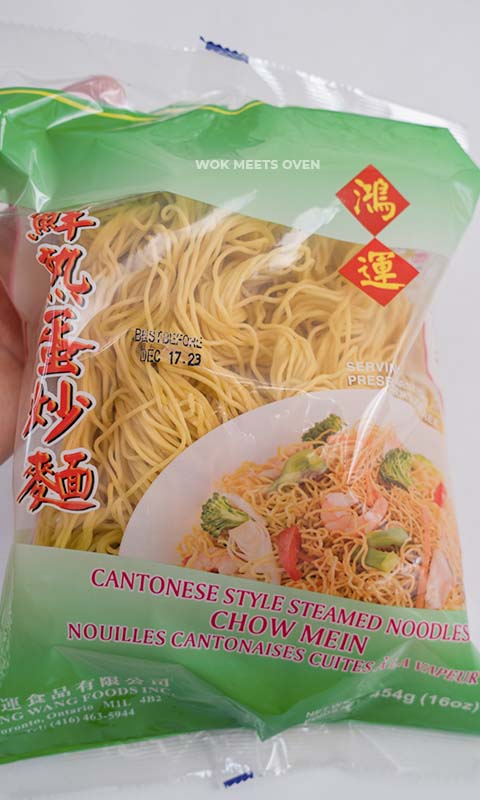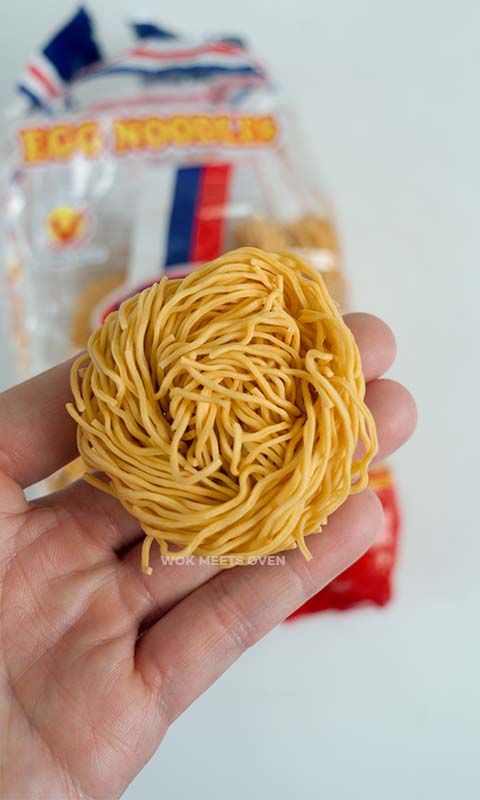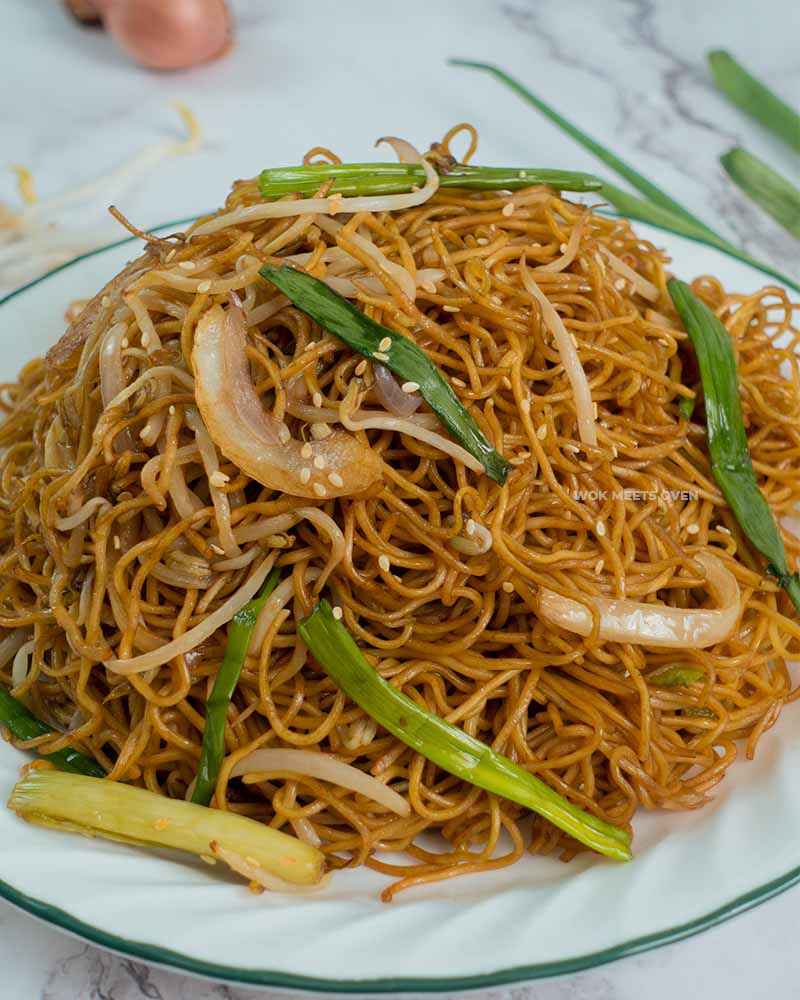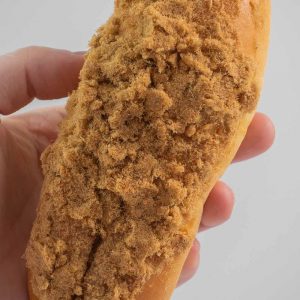Cantonese soy sauce chow mein noodles is a classic Cantonese noodle dish. Delicious egg noodles are stir-fried together with fresh beansprouts, green onions, and coated in a sweet and savory soy sauce.

Introduction
I remember devouring these savory noodles on an early Sunday morning at 8am with 2 big dark circles around my eyes while being scolded by my parents for not getting an A on all of my middle school subjects 🙄
The restaurants where we had Cantonese soy sauce chow mein noodles would almost certainly be overly crowded and you would usually need to take a number and wait for a table.
But the wait was well worth it, as you’d soon be welcomed by a plethora of tasty dim sum dishes all being served piping out of a bamboo steamer.
And to make the experience even more magical, you would see old ladies pushing out carts full of food while yelling out at the top of their lungs the name of the dishes, which in turn would prompt people from tables to yell out to them, calling them over to order the dishes.
The ladies would then plate the bamboo steamers onto your table while putting a checkmark down on your bill.
These were some of the fondest memories from my childhood.
And supreme soy sauce chow mein noodles or 豉油皇炒麵 in Chinese made up a good chunk of those memories.
What Is Chinese Soy Sauce Chow Mein?
Now if your scratching your head wondering what the heck is this guy talking about because you haven’t had much exposure to Chinese food especially Cantonese style chinese food then let me explain.
Cantonese style chinese food wouldn’t be Cantonese Chinese food without there being some supreme soy sauce chow mein noodles.
This dish is extremely popular during tea time aka. early mornings and is usually eaten at a family get together at a dim sum restaurant.
Chinese or Hong Kong soy sauce chow mein noodles (yeah, there’s a lot of different names for this dish lol) is usually comprised of soft, slightly crispy egg noodles that are stir-fried together with bean sprouts, green onion or chives, yellow onions, and coated with a sweet and savory dark sauce that gives the noodles it’s signature look.
Now Supreme soy sauce chow mein noodles should not be confused with its crispy chinese noodle cousin, the classic Hong Kong pan-fried noodles. This style of chow mein noodles involves a different technique of cooking the noodles which is pan-frying it to make the noodles extra crispy. The noodles are then smothered in a thick gravy sauce that has lots of protein and veggies. There are several different varieties of Hong Kong style chow mein, that usually include seafood, chicken, beef, pork, and a house special (mix of different proteins and vegetables). This dish is also another childhood favorite of mine, especially when I’m not too concerned about my figure 😅
Whereas Cantonese pan-fried chow mein noodles is covered with sauce and is more wet, supreme soy sauce noodles is more drier but also is coated in a delectable sauce.
The Secret Is in the Sauce
Now if you’ve ever eaten this dish before then you’ve probably been wondering what sauce is on the chow mein noodles that makes it so irresistible? Here’s a hint, it’s in the name “Soy sauce chow mein”.
Yup, that’s right, the secret ingredient is soy sauce, or rather a combination of different soy sauces (light & dark). The light soy sauce adds saltiness and flavour to the dish while the darker one is mainly used for colouring and making the noodles darker in appearance. It also has a lightly sweet and milder taste to it. When these two ingredients are combined along with a few other ingredients like sugar and oyster sauce, it makes a pretty damn good sauce that goes extremely well with the noodles.
How to Make Chinese Soy Sauce Chow Mein Noodles
While it would be great if we could just go down to our favorite Chinese dim sum restaurant to have a nice hot plate of these chow mein noodles as we please, times have changed.
Food prices are getting out of hand, especially when eating out, not to mention a lot of businesses closing their doors. You may very well not even have access to a Chinese dim sum restaurant in your neck of the woods.
Luckily though, you don’t need to wake up extra early on a weekend and drive all the way to a Chinese restaurant just to sample this dish.
Today I’m going to show you how to make Cantonese soy sauce chow mein noodles right in the comfort of your own home, because I’m sure like me, you’d rather catch up on extra sleep on the weekends after working a soul crushing job all week.
And the beauty of this dish is, it’s quick and simple to make that anyone can do it, but at the same time it tastes amazing and will have people thinking that your a great cook, even if you aren’t one 😉
Here’s what you’ll need for this Cantonese soy sauce chow mein recipe:
Ingredients
- 1 Bag of fresh chow mein noodles: 454g (can also substitute with dried egg noodles)
- Mung bean sprouts: 150-200g
- 4-5 green onion stalks
- 1 medium yellow onion
- Shallots: 2-3
Sauce:
- 3 Tbsp of Light soy sauce
- 2 Tbsp of Dark soy sauce
- 1.5 Tbsp of Oyster sauce
- 3 Tbsp of water
- 2 tsp of white granulated sugar
- Cooking oil
- 1 tsp of sesame oil (garnish)
- toasted sesame seeds (garnish) (optional)


Ingredient notes
Fresh chow mein noodles: To really get the most out of this recipe, I highly highly suggest that you use fresh chow mein noodles that are available at your local Asian supermarket. They should be regularly stocked in the fresh noodles section. If you really can’t find fresh chow mein noodles because you live in a rural area devoid of people like on mars or on top of a mountain then dried egg noodles are also fine to use. Now the cooking process will be a little different if you choose to go this route. You will need to blanch the noodles a bit longer in hot water until it becomes soft but the process is essentially the same.
But please do not use instant noodles for this dish, I beg of you 🙏 There’s a time and place for instant noodles, but it’s not here!


Vegetables: For the vegetable side of things, try to use fresh ingredients, especially the beansprouts. You can tell whether or not the beansprouts are fresh by looking at how white it is and whether or not it has started to turn translucent and slimy, EWW!!! 🤮
For this dish, you can also opt to add in Chinese chives as well, which is very common in a lot of Chinese restaurants. I’m not a big fan of them so I omitted it but if you want to be super fancy and “traditional” then feel free to add them in.
Substitutions
Noodles: You can opt for dried egg noodles or vegetarian style fresh chow mein noodles if your vegetarian.
Onion: You can use red onions in place of yellow onion if you like. It shouldn’t make a huge difference as the onions will be thoroughly cooked and thus removing the raw oniony taste.
Green onions: You can use Chinese chives in place of green onions if you’d like.
Oyster sauce: This is for all of you vegetarians out there, did you know that you could get vegetarian oyster sauce? This is the perfect substitute if you can’t use regular oyster sauce.
Directions
To start off, we’re going to prepare our noodles.
Preparing ingredients
Boil a large pot of water. Once the water is boiling, turn off the stove and then dump your pack of fresh chow mein noodles into the pot to blanch it. Loosen up the noodles so that they don’t stick together using chopsticks or tongs.
Let the noodles blanch for about a minute in the hot water before removing it from the pot and straining out all of the water.
Do not rinse the water under cold water while straining it!
Now add in a little bit of oil and then loosen up the noodles to prevent them from sticking together using chopsticks or some tongs.
Then, transfer the noodles to a tray, and line the noodles evenly on the tray to allow it to cool down and not clump together.
We’re going to air dry the noodles. This helps maintain the chewy and bouncy texture of the noodles as opposed to running it under cold water.
Next up, we’re going to prepare our vegetables and sauce.
Grab 3-4 stalks of green onion and cut them into 3-4 inch sections and keep the green and white parts separate.
Next, cut half of a medium sized yellow onion into strips and using your hands, separate each piece and then set it aside.
Then grab 2-3 small shallots and cut them into strips as well.
Next, wash and rinse your beansprouts under cold water and then drain them.
Once all of the vegetables have been prepared, set them aside.
In a small bowl, add in your light soy sauce, dark soy sauce, sugar, oyster sauce, and water. Mix everything well together and then set it aside.
Once our noodles have fully cooled down, it’s time to cook the ingredients.
Cooking the vegetables
We’re going to start by heating up a wok on medium high heat. Once you start to see smoke coming out of the wok, add in about a Tbsp of oil to the wok.
Now add in your beansprouts and stir-fry it.
We’re only going to cook this for about 30 seconds or so, just to get rid of the raw taste and maintain the crunchiness of the bean sprouts.
Once done, remove it from the wok.
Next, add in about ½ Tbsp of oil to the wok, let the oil heat up over medium heat, and then add in your onions, followed by the shallots, and the white part of the green onions.
We’re going to stir-fry this again for about 30 seconds to 1 minute to get rid of the raw taste of the vegetables.
Once you start seeing the onions turn somewhat translucent, remove everything from the wok.
Next we’re going to cook our noodles.
Cooking the Noodles
Add in about 1 ½ Tbsp of oil to the wok.
Now add in about half of your noodles. We’re going to cook the noodles in 2 batches to avoid overcrowding the wok.
Now using chopsticks, make sure that the noodles aren’t all clumped together and then try to shape the noodles into a circular shape.
Then let the noodles sit and cook for about 3 to 3 and a half minutes.
This step is crucial to making your noodles nice and crispy on the outside while still soft on the inside. If you prefer softer noodles instead, then just let them cook for about 2 minutes.
Once 3-3.5 minutes have passed and you notice the bottom is starting to get slightly crispy, flip the noodles over.
Now add a little bit of oil to the edge of the wok and let the noodles cook on this side for another 3 to 3 and ½ minutes.
Then loosen up the noodles using chopsticks.
Now add back in the vegetables that you cooked earlier. Mix everything well together then add in your sauce in batches as well so that it gets evenly coated on the noodles.
*And remember, since we’re making 2 batches of noodles, you’ll need to divide the vegetables and sauce in 2 as well.
Stir-fry everything for about a 1/2 minute and then add in the green parts of the green onion that you cut earlier.
Give it a quick few tosses then add in your sesame oil as a garnish.
Turn off the stove and give it a few tosses to incorporate the sesame oil into the noodles and then remove it from the stove.
Optional: You can sprinkle in some toasted sesame seeds onto the noodles as well if you’d like.
I recommend serving the noodles while they are hot.


Tips
Allow the blanched noodles to fully cool down before cooking them. This step not only allows the noodles to retain it’s nice bouncy and chewy texture but it also helps prevent the noodles from sticking to your wok as well. You can air dry the noodles by lining them up on a baking tray and just let nature do it’s thing.
When adding in the noodles to the wok, do not touch the noodles to allow it time to crisp up a bit.
If you prefer a slightly softer texture to your chow mein noodles then only cook them for about 2 minutes on each side. If on the other hand, you like a more crispy outter texture and a soft inner texture then cook it for about 3-3.5 minutes on each side.
When cooking the beansprouts, make sure that you are using medium-high to high heat to prevent excess water from coming out of the beansprouts. Also do not overcook the vegetables otherwise they will become overly soft and lose its crunchiness.
I recommend cooking the noodles in batches rather than overcrowding the wok so that the noodles get evenly cooked.
How to Store Leftovers and Re-Heating the Noodles
You can store any leftovers in the fridge in an airtight container. The noodles keep well for about 3-4 days. Once you are ready to eat the noodles, just simply microwave them for about 1.5-2 minutes on high.
Frequently Asked Questions (F.A.Q.S)
I’m Allergic to Egg, What Can I Substitute It With?
You can substitute regular chow mein noodles with vegetarian style chow mein noodles that don’t contain egg. They just add in food colouring to the noodles to give it that nice yellow colour but there’s no egg in it, at least that’s what they list in the ingredients. But If you end up going into anaphylactic shock due to an allergic reaction from consuming eggs, it’s not my fault.
Can I Use Instant Noodles Instead of Chow Mein Noodles?
No! Using instant noodles as a substitute for chow mein noodles is sacrilege!!! Don’t do it!
Can I Use Lo Mein Noodles as a Replacement for Fresh Chow Mein Noodles?
No! Lo mein noodles are much thicker and tend to go well with saucy dishes that allow it to soak up all of the juices. Chow mein noodles on the other hand are much thinner, and because we will be lightly pan-frying the noodles to make it slightly crispy too, you want to use thinner noodles.
Can I Use Spaghetti in Place of Chow Mein Noodles?
GET OUT!!!
What Other Types of Noodles Can I Use Instead of Chow Mein Noodles?
You can substitute vegetarian chow mein noodles if regular chow mein noodles are not available. You can also substitute fresh chow mein noodles with dried thin egg noodles as well.
Can I Use Sesame Oil to Cook the Dish?
No! Sesame oil is only used as a garnish and not to used as a substitute for cooking oil! Plus it has a strong sesame smell and flavour that will overpower anything that you cook it with if using too much.
Can I Use Lard in Place of Cooking Oil?
Absolutely, in fact some restaurants use lard to cook the dish to add a little bit of extra flavour to it. If you don’t care about your cholesterol levels and your not concerned about rapid weight gain, then sure, be my guest. I on the other hand do care about my cholesterol levels so will be sticking with cooking oil instead 😏
Why Are My Noodles Sticking Together When Cooking?
Did you rinse the blanched noodles under cold water after blanching them? Avoid rinsing the noodles under cold water right after blanching them and allow them to air dry.
Also add in about a tsp of oil to the blanched noodles after straining out all of the water and mix it to further prevent the noodles from sticking together.
Why Are My Noodles Overly Soft and Soggy?
Did you boil the noodles instead of blanching them? Did you cook the noodles for too long? We’re not making spaghetti here folks! Only blanch the noodles without the stove on for no more than 1 minute then immediately remove it from the stove and strain it.
Do I Need to Use a Wok to Make This Dish?
Nope, but I would highly recommend getting one if you intend on making a lot of Asian dishes. Plus a wok gives you way more room to mix and flip things. But in the meantime, a regular frying pan is fine 😎
Other Cooking Recipes You’ll Love
- Hong Kong Style Shredded Pork Pan-fried Noodles
- Braised E-Fu Noodles With Mushrooms
- Bacon fried rice
- Bok choy stir-fry
You can pin this image


Cantonese soy sauce chow mein noodles
Equipment
- 1 Wok
Ingredients
- 1 bag fresh chow mein noodles 454g
- 150-200 g mung bean sprouts
- 1 medium yellow onion
- 2-3 small shallots
- cooking oil
- 1 tsp sesame oil garnish at the end
- toasted sesame seeds garnish for the dish
Sauce
- 3 Tbsp light soy sauce
- 2 Tbsp dark soy sauce
- 1.5 Tbsp oyster sauce
- 3 Tbsp water
- 2 tsp white granulated sugar
Instructions
- Boil a large pot of water. Once the water is boiling, turn off the stove and then dump your pack of fresh chow mein noodles into the pot to blanch it. Loosen up the noodles so that they don't stick together using chopsticks or tongs.
- Let the noodles blanch for about a minute in the hot water before removing it from the pot and straining out all of the water. Do not rinse the water under cold water while straining it!
- Now add in a little bit of oil and then loosen up the noodles to prevent them from sticking together using chopsticks or some tongs.
- Then, transfer the noodles to a tray, and line the noodles evenly on the tray to allow it to cool down and not clump together.
- We're going to air dry the noodles. This helps maintain the chewy and bouncy texture of the noodles as opposed to running it under cold water.
- Next up, we're going to prepare our vegetables and sauce. Grab 3-4 stalks of green onion and cut them into 3-4 inch sections and keep the green and white parts separate.
- Next, cut half of a medium sized yellow onion into strips and using your hands, separate each piece and then set it aside. Then grab 2-3 small shallots and cut them into strips as well.
- Next, wash and rinse your beansprouts under cold water and then drain it. Once all of the vegetables have been prepared, set them aside.
- In a small bowl, add in your light soy sauce, dark soy sauce, sugar, oyster sauce, and water. Mix everything well together and then set it aside.
- Once our noodles have fully cooled down, it’s time to cook the ingredients.
- We’re going to start by heating up a wok on medium high heat. Once you start to see smoke coming out of the wok, add in about a Tbsp of oil to the wok.
- Now add in your beansprouts and stir-fry it.
- We’re only going to cook this for about 30 seconds or so, just to get rid of the raw taste and maintain the crunchiness of the bean sprouts. Once done, remove it from the wok.
- Next, add in about ½ Tbsp of oil to the wok, let the oil heat up over medium heat, and then add in your onions, followed by the shallots, and the white part of the green onions.
- We’re going to stir-fry this again for about 30 seconds to 1 minute to get rid of the raw taste of the vegetables.
- Once you start seeing the onions turn somewhat translucent, remove everything from the wok. Next we're going to cook our noodles.
- Add in about 1 ½ Tbsp of oil to the wok. Now add in about half of your noodles. We're going to cook the noodles in 2 batches to avoid overcrowding the wok.
- Now using chopsticks, make sure that the noodles aren’t all clumped together and then try to shape the noodles into a circular shape.
- Then let the noodles sit and cook for about 3 to 3 and a half minutes.
- This step is crucial to making your noodles nice and crispy on the outside while still soft on the inside. If you prefer softer noodles instead, then just let them cook for about 2 minutes.
- Once 3-3.5 minutes have passed and you notice the bottom is starting to get slightly crispy, flip the noodles over.
- Now add a little bit of oil to the edge of the wok and let the noodles cook on this side for another 3 to 3 and ½ minutes. Then loosen up the noodles using chopsticks.
- Now add back in the vegetables that you cooked earlier. Mix everything well together then add in your sauce in batches as well so that it gets evenly coated on the noodles.
- *And remember, since we're making 2 batches of noodles, you'll need to divide the vegetables and sauce in 2 as well.
- Stir-fry everything for about a 1/2 minute and then add in the green parts of the green onion that you cut earlier.
- Give it a quick few tosses then add in your sesame oil as a garnish. Turn off the stove and give it a few tosses to incorporate the sesame oil into the noodles and then remove it from the stove.
- Optional: You can sprinkle in some toasted sesame seeds onto the noodles as well if you'd like.





Leave a Reply